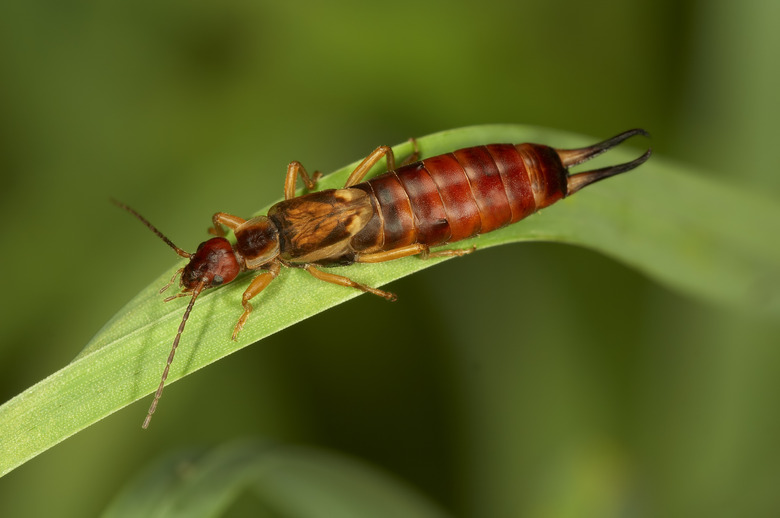Why Do I Have So Many Pincher Bugs In My House?
Pincher bugs, also known as earwigs, live throughout the United States but are most commonly found in southern climates. These small, unusual-looking insects are ¾ of an inch long and reddish-brown. They have a tail that resembles forceps, with pincers that extend from their abdomen and two pairs of leathery-looking wings, with the hind wings folding under the front ones. There are over 20 species of pincher bugs around the country, and while they may look creepy, they're neither poisonous nor do they spread disease. Pincher bugs are fast and nocturnal, selecting habitats like decaying wood, plants and other dark, moist spaces.
These insects are both beneficial and harmful to our lifestyle. While they do consume other insects, they'll also dine on your garden. They enjoy munching on living plants like vegetables, fruit trees and ornamentals. Their favorites are flowers, lettuce, celery and fruits. They'll damage the leaves of plants, leaving behind jagged edges and holes throughout. Your plants may appear ragged overnight. Pincher bugs are social insects and live in nests with thousands of other pincher bugs.
How Do Pincher Bugs Get Inside Your Home?
How Do Pincher Bugs Get Inside Your Home?
These bugs are attracted to lights, and on summer evenings they may find their way onto your porch or patio. By morning, they'll nest under objects, such as pillows or cushions, that were left out overnight. A change in weather can cause them to move into your home. They may come inside because they're seeking shelter, have simply wandered in or are in search of a cool, damp area during a dry spell.
Your gardens and home will be more susceptible to pincher bugs during rainy periods. When they enter your home, you'll often find them in rooms with water, such as kitchens, bathrooms or damp basements. However, they'll also wander into bedrooms and family areas. While you may find them throughout your house, infestations are rare.
Indoor Prevention Begins Outside
Indoor Prevention Begins Outside
To keep these insects from entering your home, you need to protect the exterior. You should keep the area around your home's foundation as dry as possible. Don't place mulch or other moist materials near your house. Check your drainage to make sure that all gutters and downspouts are sending water away from the foundation. If you have an irrigation system, it should run in the morning so the warmth of the day can dry the ground. As pincher bugs are attracted to light, turn all outdoor lighting to shine on your yard. If moving your lights isn't possible, yellow light bulbs will attract fewer insects. It's also important to review all entry points into your home to confirm your vents aren't blocked and any screen damage is repaired.
Landscaping should also play a role in prevention. In addition to keeping the area near your home dry, make sure that the pincher bug's preferred plants aren't grown near walls that are covered in either ivy or hedges. For trees and shrubbery that are close to your house, trim them regularly to prevent creating damp and shady areas. If you have chosen to use decorative stones as landscaping or have a pile of firewood, keep them away from the foundation. Creating a bird-friendly and/or toad-friendly garden is also beneficial as they're predators of the pincher bug.
If Pincher Bugs Sneak Inside
If Pincher Bugs Sneak Inside
Each time you enter your home, check for bugs! Look at your body and clothing to see if any of these insects attached themselves. Don't forget to check everything that comes inside with you. Your shoes, clothing, flowers, fruits/vegetables and even firewood could carry these insects into your home. If you do see a pincher bug crawling around your house, vacuum it up. If there are numerous bugs, an exterminator can inspect and spray your home.
